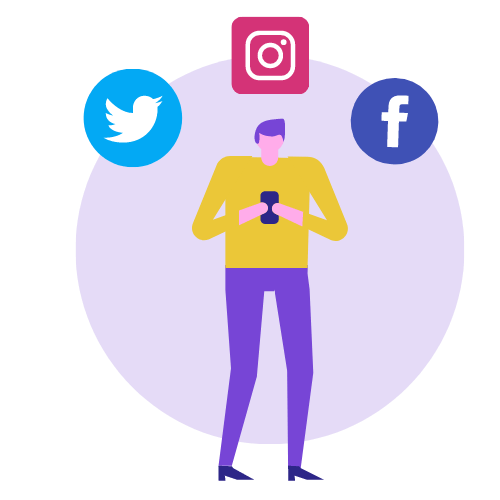What Nonprofits Should Know About Digital Marketing in 2022


Heading into 2022, you’re probably reviewing your list of New Year’s resolutions. As a nonprofit marketing professional, you might have listed “improve our digital marketing strategy” underneath “get into jogging” and “eat more veggies.”
The nonprofit digital marketing landscape constantly evolves, meaning marketing professionals need to stay aware of current trends to engage donors and other supporters effectively online.
With the ongoing pandemic, technological innovations, demographic changes, and other important trends, digital marketing in 2022 will present multiple challenges and opportunities to nonprofits. Here’s what your organization should know to engage with your online audience most effectively in the new year:
According to AccuData’s guide to digital marketing, the role of digital advertising is to “meet your organization’s audience where they’re already active—on technology.” In 2022, supporters will be spending more time than ever before using devices such as smartphones, tablets, and laptops. These tips will help you meet supporters where they live, work, and play to engage them in your worthwhile mission.
1. Donor segmentation remains vital
Donor Segmentation allows you to speak to supporters on a more personal level and send them highly relevant content.
Personalization is crucial for effective direct marketing because supporters want to feel acknowledged as individuals. Keen audience members can easily spot the difference between tailored marketing and generic, mass-produced content.
To adopt an effective segmentation strategy, group your contacts based on shared motivations or interests. For example, you might create segments for your volunteers, new donors, and long-time donors.
Then, you can send each group newsletters and other email content that appeals to their interests. You can send information about upcoming volunteer opportunities to your volunteers, details about your organization’s history to your new donors, and new ways to get involved to your long-time supporters.
When your messages appeal to supporters’ interests and motivations, they’re more likely to engage with the content.
2. The effects of the pandemic will continue impacting nonprofit marketing
The pandemic ushered in an era of increased digital marketing. A Mapp marketing survey found that 65% of marketers have accelerated their use of innovative digital and technology strategies more than they had intended as a result of the pandemic.
As we finish up year two of the pandemic, your supporters are looking for unique virtual experiences to combat screen fatigue. Even though your nonprofit’s ability to host in-person events might be restricted, you can still offer supporters valuable online experiences that engage them remotely.
Keep your virtual engagement strategy flexible and engaging with new virtual event ideas such as online auctions, behind-the-scenes tours, or live-streamed concerts. Show supporters something they haven’t seen before within the last two years of pandemic-era digital engagement.
3. Nonprofits must adopt innovative targeting techniques to remain competitive
Nowadays, your organization can’t just rely on having a solid website and social media presence to power your entire marketing strategy.
While it’s important to shore up these digital platforms, it’s also important to target donors individually. This allows you to get your content in front of more supporters using a proactive approach.
Consider adopting one of the following targeted marketing strategies:
- Location-based marketing, such as geofencing. Geofencing marketing allows you to reach targeted audiences using geographic data. Using this technique, you can reach supporters who have attended your events in the past or visited your nonprofit’s location.
- Google Ads. With Google Ads, you can incorporate search-engine marketing into your digital strategy. Plus, with Google Ad Grants for nonprofits, your organization can gain access to $10,000 credits per month to use on Google advertising. This increases the likelihood that your organization’s content will appear at the top of the search results for relevant terms.
- Text fundraising. Text fundraising, such as a text-to-give campaign, allows you to reach supporters on a device they constantly use: their smartphones! With text fundraising, you can cut through some of the digital clutter by reaching supporters on a personal level.
These strategies allow you to differentiate your nonprofit from similar organizations and keep your campaigns front-of-mind for current and potential supporters.
Don’t waste your Google Ads Grant!
Use this Free Campaign Planner to organize your nonprofit’s campaigns, plan keywords, and save valuable time.
4. Supporters expect a convenient donation process
With the rise of social fundraising platforms like Facebook Fundraising, nonprofit supporters are wired to expect a simple, convenient online donation process. They expect to be able to donate no matter where they are or what device they are using.
The data makes this trend clear — according to Double the Donation’s fundraising statistics, 50% of all nonprofit website traffic in 2018 came from mobile and tablet users, a trend that only continues growing in recent years.
Audit your website to ensure it’s designed to facilitate a streamlined donor journey. Make sure that your:
- Content is up-to-date.
- Design and layout are streamlined and accessible.
- User experience is straightforward and hassle-free.
This ensures that you’re exceeding supporters’ expectations when it comes to an easy, convenient donation process.
5. Storytelling is the key to better digital content.
Above all else, nonprofit supporters seek authenticity. This is especially true of your younger supporters. A recent study found that 82% of Gen Z, individuals born between 1996-2015, will trust a company more if it uses photos of real customers in its ads.
Incorporate storytelling into your digital marketing efforts to capture supporters’ attention and create more genuine connections.
Share real stories from your constituents, staff members, and volunteers on your digital platforms. Also, be sure to use original photos rather than stock images in your email, website, and social media content. This helps infuse authenticity into your digital content.
6. Nonprofits will continue seeing success with a multiplatform social media strategy.
Not all social media platforms reach the same audiences or help you achieve the same goals. In 2022, the nonprofit marketing landscape will be dominated by a handful of digital platforms that appeal to different demographics and feature different types of content.
Here’s what you need to know about each digital marketing platform in 2022:
- Facebook: It’s no secret that Facebook has taken some hits to its popularity. Younger generations, such as Millennials and Gen Z, are using the platform less and less.Although the company has faced political and legal backlash due to privacy and political polarization issues, Facebook remains the world’s most popular social media platform, with 2.9 billion active users. Plus, Facebook users have raised more than $5 billion through the platform, representing a major fundraising opportunity. This means Facebook should still be an important element of your digital marketing strategy in 2022.
- TikTok: TikTok is rapidly becoming one of the most influential social media platforms, with 1 billion active users. MostTikTok users are from the Gen Z cohort, meaning this is a valuable platform to engage your younger supporters. Keep an eye out for TikTok trends or visually appealing content that you can share with your audience. You can also use TikTok to share videos of your constituents or staff members explaining your nonprofit’s vision and mission.
- Instagram: Instagram continues to capture social media users’ attention, especially Gen Z and Millenials. Features such as Instagram Live and Stories provide unique ways to connect with your followers and give them a behind-the-scenes look at your nonprofit’s projects and initiatives.
- LinkedIn: Known as the professional social media platform, LinkedIn is popular for networking and workplace-related content. Incorporating LinkedIn into your nonprofit digital marketing strategy offers several benefits. You can identify and reach out to prospective major donors based on their job titles and other employment information. You can also use the platform to find skilled volunteers and scrape LinkedIn for their email addresses.
Social media allows you to spread awareness of your organization’s mission, share your online fundraising campaigns, and connect with current and prospective donors. All in all, it’s a highly valuable marketing channel that will only grow in importance as more and more individuals join these platforms.


On-Demand Webinar: Social Media Marketing 101 for Nonprofits
Learn how to implement social media marketing and best reach your donors.
Brush up on some social media marketing essentials to ensure you’re approaching social outreach effectively in 2022.
The new year brings new opportunities to engage with new and long-time supporters alike. Keeping up with digital trends will allow your nonprofit to make the most of its 2022 digital marketing budget. It’s also important to keep your digital marketing plans flexible. Stay updated on new nonprofit digital marketing trends, platforms, and features throughout the year to adapt your marketing strategy to changing circumstances. Good luck!
See How Nonprofits Use Keela to Raise 4x More!
Get a glimpse of how Keela’s donor management system can help you develop better relationships, retain donors and raise more for your cause.


About the author:
Gabrielle Perham, MBA, Director of Marketing at AccuData
Gabrielle is the Director of Marketing for AccuData Integrated Marketing. She joined the organization in 2017 and possesses more than 15 years of experience in strategic marketing, branding, communications, and digital marketing. She earned a B.S. in Marketing and an M.B.A in Marketing Management from the University of Tampa.


